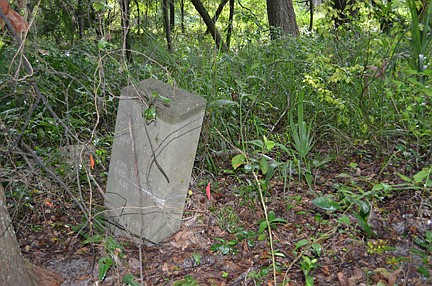- April 4, 2025
-
-
Loading

A falling headstone stands among the weeds at the Oakland African-American Historic Cemetery.
Tucked deep in a wooded area just north of West Colonial Drive, mostly hidden among weeds, downed limbs, giant banana-spider webs and debris, are the final resting places of some of the earliest residents of Oakland. There’s James W. Walker, whose family was one of the first to settle in the town; another family member is buried nearby. There are many children, too, in the Oakland African-American Historic Cemetery, which the town now operates.
The Cemetery Board quit-claimed the land, approximately three acres in size, to the town so the cemetery could be better taken care of. The small board had not been active; one member moved out of state and another was an elderly man with health problems.
A history
The original land grant was documented in 1882, according to the Winter Garden Heritage Foundation.
No one seems to know how many people are buried in this cemetery, some as early as the 1880s and as late as 1949. It is known that a large number died in the 1918 flu pandemic and are laid to rest here.
After the 1940s, when people were no longer being buried in the cemetery and visitors became scarce, vegetation grew rampant, concealing many of the headstones in their own mossy tomb.
Castle & Cooke, a company that develops master-planned communities, purchased a two-acre section of the land about a decade ago to use as a connector between West Colonial Drive and a project the company proposed behind the cemetery. It also agreed to maintain the cemetery, but Oakland resident Betty Wade — who is a member of the small cemetery committee and has several relatives buried there — said when the construction industry plummeted soon after, Castle & Cooke no longer had the funds to keep up with cemetery maintenance.
Once again, it became a neglected and forgotten parcel of land.
The cemetery was rediscovered when Florida’s Turnpike Authority officials were at the site to discuss road-widening plans. Ground-penetrating radar located the bodies, and a chain-link fence was installed around the perimeter. Clean-up began and some trees were removed, but that work eventually came to a stand still.
At rest
A roster of the deceased has been compiled from various sources, including a site file survey, actual headstones and a research team that met with older residents and asked them to list who is buried in the cemetery.
James W. Walker was Wade’s grandfather. He lies near others who founded the town and whose names are emblazoned on street signs around old Oakland: Samuel Eliza Pollard and Lizzie Pollard, James and Juna Jefferson, Sing Jefferson and Aaron Herriot (although the street name has two T’s).
Oakland resident Masrine Gibson’s mother, Catherine Gaddis, is buried there. Celeste Pierce and her sister, both midwives a lifetime ago, are there. So are Samuel and Mellie Pierce, Martha McClarey and Mary McClarey, Thelma Sullivan, Samuel Woodall, Janice Mcamgo, Priscilla Taylor and Bulah Brunson. Headstones reveal the names of Mallie Pierson, Liza Fulton and Robert Moses Johnson (born 1899, succumbed to the flu in 1918).
Moving forward
A Boy Scout troop has taken on the challenge of helping clean up the cemetery and building a new entrance off of Oakland Avenue. Wade said the scouts received donated wrought iron that will be installed, and PVC pipe donated to the town will replace the old tin markers that are faded and rusted and no longer identify the person buried beneath them.
“We’re hoping to be able to locate some kind of grant monies to start working on it,” Wade said. “Getting the town to take over the cemetery was big. They can better handle the day-to-day maintenance.”
After the work is completed, the town will apply for entry in the National Register of Historic Places.
A banana spider spins an elaborate web in the wooded Oakland African-American Historic Cemetery.
A rusted grave marker, nearly invisible in the weeds, is flagged so a PVC pipe can be placed there.